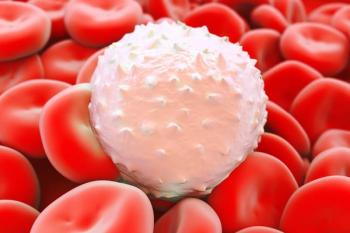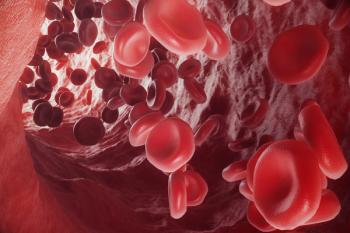
Pamrevlumab Combo Does Not Improve Survival in Advanced Pancreatic Cancer
Results from the phase 3 LAPIS trial showed pamrevlumab/chemotherapy did not improve survival vs placebo/chemotherapy in locally advanced, unresectable pancreatic cancer.
The phase 3 LAPIS trial (NCT03941093) found that pamrevlumab plus chemotherapy did not incur additional toxicity, but there were no improved survival outcomes for patients with locally advanced, unresectable pancreatic cancer (LAPC), according to results presented at the
Topline results in the combination arm included a median overall survival (OS) of 17.3 months compared with 18.0 months in the placebo arm (HR, 1.08; 95% CI, 0.83-1.41; P = .5487). The median EFS was 5.7 months in the combination arm and 5.8 months in the placebo arm (HR, 1.05; 95% CI, 0.78-1.39).
Additional efficacy data included a median progression-free survival (PFS) of 9.4 months in the pamrevlumab plus chemotherapy arm and 9.4 months in the placebo arm (HR, 1.01; 95% CI, 0.65-1.56). The overall response rate in each arm was 30.1% and 45.4% (OR, 0.50; 95% CI, 0.31-0.82), respectively, and this was comprised of all partial responses.
“The LAPIS findings provide valuable insights into the challenges of treating LAPC, and the LAPIS trial design innovations and end points may influence future trial design by enabling shorter, more targeted trials,” Vincent Picozzi, MD, a medical oncologist from Virginia Mason Franciscan Health, stated during the presentation.
Overall, 284 patients were enrolled in either the combination arm (n = 143) or the placebo arm (n = 141). Patients were randomly assigned 1:1 to either the combination arm or the comparator arm. The combination arm received pamrevlumab at 35 mg/kg every 2 weeks plus chemotherapy and the comparator arm received placebo plus chemotherapy. The chemotherapy regimen consisted of gemcitabine, nab-paclitaxel (Abraxane), or leucovorin calcium, fluorouracil, irinotecan hydrochloride, and oxaliplatin. Treatment was given in six, 28-day cycles.2
Overall, 64.8% of patients in the combination arm and 68.1% in the placebo arm completed 6 cycles of treatment. For patients with reconstructible disease, surgical outcomes were similar. Of note, 67.6% in the combination arm and 65.7% in the placebo arm completed 6 cycles of chemotherapy and were considered for surgery. Additionally, 14.7% of patients in the pamrevlumab arm and 20.0% in the placebo arm met the eligibility for surgical exploration, and 8.8% vs 8.6% had “Resection Achieved” status.
The primary end point was OS. Secondary end points included EFS, PFS, and the number of patients with the best ORR.
Patients were eligible for resection based on changes in CA19-9, standard uptake value (SUVmax) on FDG-PET, resectability, and anatomic imaging. The final surgical decision was made by an investigating surgeon.
Picozzi noted that the adverse effect severity and frequency, and surgical complications remained similar between groups. One patient died from pneumonia in the combination arm, which was treatment-related.
Some limitations of the study included:
- Patients having non reconstructible disease at baseline may limit the ability for curative resection and survival.
- Not requiring staging laparoscopy.
- The variability in supportive care.
- The occurrence of the trial during a global pandemic may have negatively impacted survival.
Reference
- Picozzi VJ, Khan K, Hammel P, et al. LAPIS: Randomized phase 3 trial of chemotherapy (CTX) with and without pamrevlumab (PAM) for locally advanced pancreatic cancer (LAPC). J Clin Oncol. 2025;43(4):675. doi:10.1200/JCO.2025.43.4_suppl.675
- Evaluation of efficacy and safety of neoadjuvant treatment with pamrevlumab in combination with chemotherapy (either gemcitabine plus nab-paclitaxel or FOLFIRINOX) in participants with locally advanced, unresectable pancreatic cancer (LAPIS). ClinicalTrials.gov. Accessed January 24, 2025. https://shorturl.at/gOBTd
Newsletter
Stay up to date on recent advances in the multidisciplinary approach to cancer.

















































































